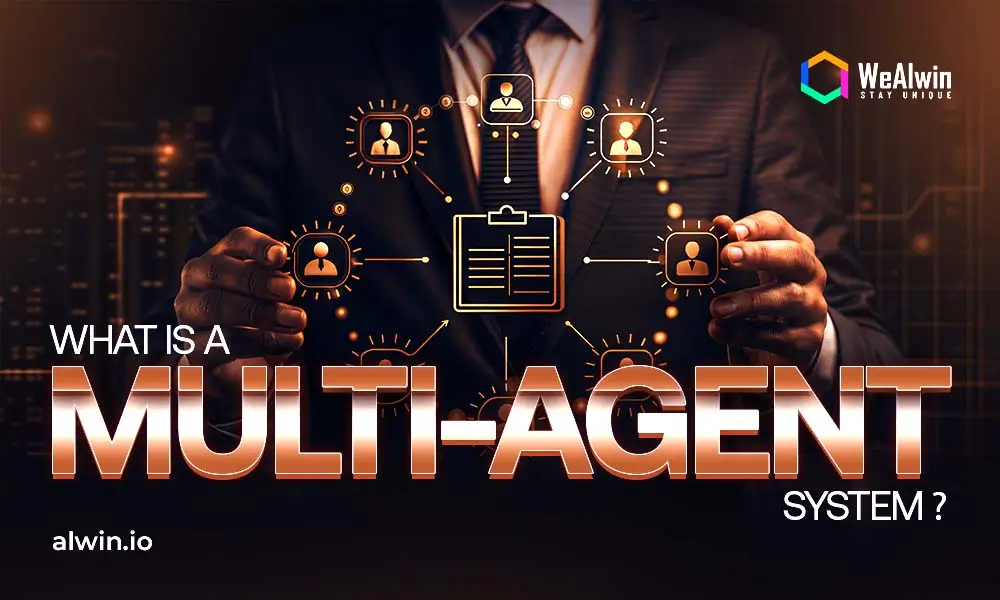Multi-agent systems were inspired by how different entities can collaborate to complete tasks that would be impossible for a single system to handle alone. The systems were originally designed to model collaborative behavior in robotics, distributed computing, and even economics. Global adoption of technology continues to rise as it becomes a vital part of sectors like logistics, healthcare, and finance.
Across industries, multi-agent systems are gaining in popularity. Advancements in AI and automation are expected to propel the global multi-agent systems industry to a significant expansion. MAS's capacity to handle multiple processes simultaneously, according to studies, has led to a 30% boost in operational effectiveness for businesses employing it.
In this blog, we’ll explore how multi-agent systems work, their benefits, and why they’re becoming indispensable in solving modern challenges.
What is a Multi-Agent System?
A multi-agent system (MAS) consists of multiple autonomous agents that interact with each other to resolve challenging issues or complete tasks. The agents in the system work on their own, but they're designed to communicate and work together to accomplish a common objective. These agents can represent people, machines, software, or processes, and they work together in a way that reflects how human teams cooperate to complete projects.
How Do Multi-Agent Systems Work?
The collaboration of multiple autonomous agents is what makes multi-agent systems work. These agents are independent and able to take actions and make decisions on their own, but they're also programmed to work together to accomplish common objectives. This is a breakdown of how these systems work,
Autonomous Agents
Each agent in a multi-agent system works independently. Decision-making capabilities and the ability to act on their environment are what they are programmed with. In contrast to centralized systems, where a single entity oversees all operations, each participant in MAS is accountable for its specific task.
For example, In a warehouse management system, one agent might handle inventory, another might handle shipping schedules, and another might track product deliveries. Each agent works independently, but they all contribute to the overall operation.
Communication and Coordination
Agents in MAS communicate with each other to exchange data, work together on projects, or settle disputes. Communication is done through message-passing protocols or shared environments where agents can exchange data.
The coordination allows agents to solve problems that would be too complex for a single agent. For instance, In a traffic control system, each traffic light acts as an agent, communicating with nearby lights to optimize the flow of vehicles across the entire city.
Distributed Decision-Making
Decision-making is distributed in a multi-agent system because there is no central authority. Agents make decisions based on local information and interactions with other agents. These decisions together contribute to the system's overall objective.
A financial market simulation, for instance, has individual agents representing buyers and sellers making their own decisions on trades based on market information, but their collective actions have a significant impact on the market's overall trends and pricing.
Adaptability and Learning
Many multi-agent platforms employ AI or machine learning techniques that permit agents to alter their actions over time. Agents learn from their experiences and interactions, allowing them to better handle future tasks or changes in the environment.
Different cars (agents) might learn how to navigate traffic by adjusting their driving behavior based on real-time information from other vehicles and road conditions in an autonomous driving system.
Collaboration vs Competition
The goal of a multi-agent system is to collaborate or compete.
Agents work together to achieve a common goal. In robotics, for instance, a group of robots might work together to accomplish a task, such as constructing a structure or exploring a fresh locale.
Agents may compete in order to maximize individual outcomes, as seen in online trading platforms where agents (buyers and sellers) aim to get the best deal based on the current market dynamics.
Task Decomposition
Task decomposition is a technique used in multi-agent systems where complex tasks are broken down into smaller, more manageable sub-tasks. The system can tackle large problems in parallel by assigning one or more of these sub-tasks to each agent. Large-scale, complex challenges are made possible by this distributed approach.
Difference Between Single-Agent and Multi-Agent Systems
This table shows the main differences between single-agent and multi-agent systems.
| Criteria |
Single-Agent System |
Multi-Agent System (MAS) |
| Number of Agents |
Involves a single autonomous agent |
Involves multiple autonomous agents working together or competing. |
| Communication |
No need for communication as there is only one agent. |
Agents communicate and coordinate with each other for task completion. |
| Decision-Making |
Centralized decision-making by the single agent. |
Decentralized decision-making; each agent makes independent decisions. |
| Task Complexity |
Suitable for simpler tasks that don’t require collaboration. |
Handles more complex tasks that can be divided and solved in parallel. |
Benefits of Multi-Agent Systems
Multi-agent systems (MAS) have many benefits, especially for solving difficult and distributed problems. Here are some of the main advantages of using MAS.
Scalability
Multi-agent systems are great because they can grow quickly. When a problem gets more complicated, more people can join the system and do some of the work. MAS is perfect for big, dynamic applications like smart grids, logistics, and traffic management.
Parallel Problem Solving
In MAS, multiple agents work on the same part of the problem at the same time, allowing for parallel processing. This leads to faster solutions and better use of resources. In situations like supply chain management, different people can buy things, keep track of what they have, and send them out at the same time.
Flexibility and Adaptability
Multi-agent systems can adapt to changing environments in real time. Agents can change their behavior based on feedback from the environment or from other agents, making the system more flexible and robust. This ability to adapt is especially useful in real-time decision-making environments, like financial trading or emergency response systems.
Decentralized Control
Unlike traditional systems that rely on central control, MAS works in a decentralized way. This means that if one part of the system fails, the rest can continue working without big problems. This redundancy makes MAS more resilient and reliable, especially in important systems like air traffic control or disaster management.
Improved Efficiency
Agents in a MAS can do specific tasks without waiting for a central controller to tell them. This makes tasks easier to do because people can work independently and help reach the goal. For example, in robotics, different robots can be assigned different tasks in a factory, improving production speed and accuracy.
Distributed Decision Making
In MAS, different people make decisions. This decentralization lets each agent make decisions based on local information and how they interact with other agents. This is especially helpful in systems like smart cities, where multiple agents can make decisions in real time to improve traffic flow, reduce energy consumption, or manage resources.
Robustness
Multi-agent systems are designed to be strong. The system doesn't rely on just one thing, so if one thing fails, the whole thing won't fail. This makes MAS good for important tasks like managing healthcare.
Collaboration and Coordination
In multi-agent systems, many agents can work together to accomplish difficult tasks that would be too difficult for one agent alone. Through communication and coordination, agents can share information, work together on tasks, and improve solutions. This collaboration is especially useful in situations like disaster relief, where different agents (rescue teams, medical units, logistics providers) work together to address multiple challenges at once.
Cost-Effectiveness
MAS can save money by giving tasks to many people. In manufacturing, many people can control different parts of the process to use resources efficiently and reduce waste. This leads to cost savings and more streamlined operations.
Multi-agent systems have substantial benefits in terms of scalability, flexibility, efficiency, and robustness. MAS can handle complex tasks in a wide range of industries, making them a powerful tool for modern technology solutions. From parallel problem-solving to distributed decision-making, MAS can handle complex tasks in a wide range of industries. The future of MAS continues to grow, whether it's in robotics, transportation, or smart cities.
Use cases of Multi-Agent Systems
Due to their ability to handle complex, distributed tasks, multi-agent systems have become widely used in a variety of industries. Some prominent examples of how MAS is used in different industries are listed.
Robotic Swarms
Multiple robots (agents) work together to complete tasks that would be impossible or inefficient for a single robot. The way ants or bees work together to achieve their objectives is an inspiration for these systems. Applications like:
Example- To locate survivors in disaster areas.
Traffic management systems
In urban traffic control, multi-agent systems manage traffic lights, vehicles, and traffic flow in real time. Each traffic light acts as an agent, communicating with others to adjust timings and keep traffic flowing smoothly.
Supply Chain Management
Supply chain management uses multi-agent systems where different agents represent different parts of the chain. Agents work collaboratively to:
Optimize production: Material and goods should flow efficiently from suppliers to customers.
Adapt to changes: Adjust processes based on real-time information, such as missed deliveries or unexpected demand surges.
Financial Trading Systems
Automated financial trading relies heavily on the MAS. Each agent acts as a trader, making independent decisions based on market data.
Example- Stock prices change in real time, making the market more responsive. , Programmable strategies allow agents to buy and sell stocks quickly.
Smart Grids
Energy production, distribution, and consumption are managed by multiple agents in smart grid systems. Agents work together to balance the supply and demand of energy in real time.
Healthcare Management
Healthcare management systems are also incorporating multi-agent systems to help coordinate care between different healthcare providers, patients, and resources.
E-commerce
E-commerce platforms employ MAS to improve the customer encounter. Users' preferences are learned by agents in these systems, and they suggest goods accordingly.
Autonomous Vehicles
Autonomous driving technology uses vehicles as agents in a multi-agent system. MAS are employed in distributed manufacturing to oversee various phases of the production cycle.
Distribution Manufacturing
Each step in the process is overseen by an individual agent, who collaborates with others to ensure the effective production of goods.
Example- Robots and machines work in parallel to complete different stages of production.
Space Exploration
A group of robots or rovers that explore distant planets are controlled by multi-agent systems in space exploration. Each robot functions as an agent that collects data and performs tasks independently, while also communicating with the other robots and Earth-based controllers.
Various industries are employing multi-agent platforms, providing enhanced extensibility, effectiveness, and flexibility. MAS provides innovative solutions to complex challenges, making them an essential tool for the future of distributed systems, from robotic swarms and traffic management to financial trading and autonomous vehicles.
Ending Thoughts
Looking ahead, multi-agent systems (MAS) are set to play a bigger part in reshaping various industries. Financial trading and health care are some of the applications of MAS that are constantly expanding. They're great at tackling tough issues, adjusting to new situations, and working on their own in today's connected, fast-paced world.
We can expect MAS to become more intelligent, collaborative, and efficient with advancements in artificial intelligence and machine learning. The demand for more scalable, flexible, and decentralized solutions will continue to push the boundaries of what MAS can achieve, making them a cornerstone of future technology.
Businesses that adopt multi-agent systems can gain a strong advantage in today’s competitive market by using this advanced technology.



